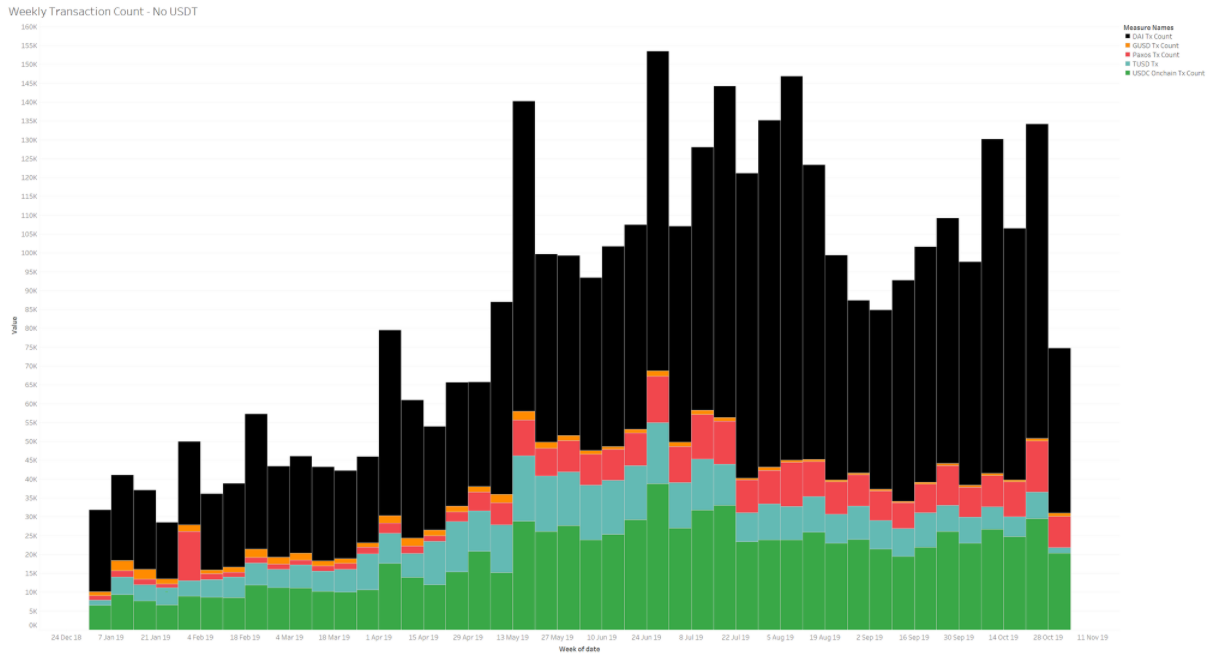Stablecoins on Ethereum had a cumulative transfer volume greater than its native ETH in 2019. This point indicates larger trends at play that could change the broader crypto landscape.
The Advent of Stable Money in Crypto
Data from Messari Research suggests ETH’s trailing 12 month transfer volume fell from approximately $430 billion to $150 billion over the course of 2019.
At the same time, stablecoins also followed ETH’s downtrend until July 2019, when these assets began picking up steam.
1/ Stablecoin transfer value has now flipped ETH on Ethereum 👀 pic.twitter.com/wwlNF2ObOV
— Ryan Watkins (@RyanWatkins_) January 29, 2020
Tether (USDT), in particular, saw significant traction as the project migrated tokens from Omni to Ethereum. But this wasn’t the sole reason for USDT’s volume spike.
On a daily basis, USDT enjoys volume that dwarfs its market cap in comparison. As per CoinGecko data, USDT has a market cap of $4.28 billion and a 24-hour volume of $55.97 billion.
This massive volume comes from Tether’s moat as the stablecoin of choice for investors and traders looking for an easy cash hedge without leaving the cryptocurrency ecosystem.
However, USDT wasn’t the only stablecoin that gained ground in 2019. Joel John, an analyst at Outlier Ventures, investigated the state of stablecoins in early December 2019. In a blog post, he highlighted how DAI has gone from strength-to-strength, finally finding product-market fit alongside the rise of DeFi.

While USDC and DAI are fighting for dominance as the stablecoin of choice for DeFi’s yield hunters, DAI has been mostly winning this battle due to its permissionless nature.
It remains to be seen if the top DeFi protocols like Compound plan to create USDT money markets, but the possibility cannot be ruled out as more tokens migrate to Ethereum’s ERC-20 standard.
DeFi Value Creation Linked to Stablecoin Growth
On Jan. 30, 2019, the total dollar value locked in DeFi was $240 million. Precisely one year later, this value has grown by nearly four times to $856 million.
As the bull market in the first half of 2019 unwound, lending stablecoins on DeFi provided a unique opportunity for investors to hedge into cash and earn passive income. Crypto lending existed long before this, but DeFi allowed for this same opportunity at a market-oriented interest rate without giving up custody of one’s assets.
At the height of yield mania induced by this very opportunity, lending DAI and USDC generated 13.38% and 10.03% respectively on an annualized basis. In hindsight, an investor could’ve exited positions in BTC, ETH, or any other volatile crypto asset, purchased stablecoins, and invested it in a permissionless money market.
As the major digital assets corrected by over 50%, it’s no wonder stablecoins picked up traction while ETH continued to see transfer volume dwindle.
Stablecoin’s Gain Is Not Ethereum’s Loss
The prosperity of stablecoins and the protocol they run on are not mutually exclusive. On the contrary, the rise of stablecoins on Ethereum represents a legitimate use case of Ethereum’s programmability.
To send DAI, USDC, or ERC-20 USDT, users have to have ETH in their wallet to pay gas fees to miners. Most financial dApps also run on Ethereum, giving it a distinct advantage over competitors.

Lastly, the decrease in transfer volume can be interpreted as a bullish indicator too. It shows that ETH investors are developing stronger hands by accumulating ETH and not giving into short term expectations. Bitcoin’s adjusted transfer volume has also been on the decline since June 2019.
If anything, this means that BTC and ETH are both in accumulation stages.
